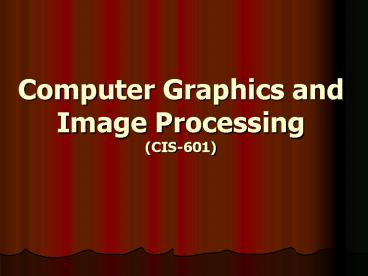Computer Graphics and Image Processing (CIS-601) - PowerPoint PPT Presentation
1 / 37
Title:
Computer Graphics and Image Processing (CIS-601)
Description:
Computer Graphics and Image Processing (CIS-601) Image Segmentation by Clustering (Using Mahalanobis Distance) - Manjit Chintapalli What is Image Segmentation ? – PowerPoint PPT presentation
Number of Views:83
Avg rating:3.0/5.0
Title: Computer Graphics and Image Processing (CIS-601)
1
Computer Graphics and Image Processing (CIS-601)
2
Image Segmentation by Clustering (Using
Mahalanobis Distance)
- - Manjit Chintapalli
3
What is Image Segmentation ?
- To humans, an image is not just a random
collection of pixels it is a meaningful
arrangement of regions and objects. - There also exits a variety of images natural
scenes, paintings, etc. Despite the large
variations of these images, humans have no
problem to interpret them.
4
Image Segmentation ? (Contd..)
- Image segmentation is the first step in image
analysis and pattern recognition. - It is a critical and essential component of image
analysis system, is one of the most difficult
tasks in image processing, and determines the
quality of the final result of analysis.
5
The Process
- Image segmentation is the process of dividing an
image into different regions such that each
region is homogeneous.
6
Image Segmentation methods
7
Image segmentation methods can be categorized as
follows (this is not an exhaustive list)
- Histogram thresholding
- Edge-based approaches
- Region-based approaches
- Hybrid consider both edges and regions.
8
Continued
- Segmentation of texture by PCA
- Segmentation of texture with moments
9
Color Image Segmentation
- Image segmentation based on color
- We use clustering to segment an image according
to color features
10
Clustering ?
- Clustering is a common step to get a segmentation
- In the data space, clusters are regarded as
regions of similar data points
11
Clustering.
Similar data points grouped together into
clusters.
12
Clustering
- Most popular clustering algorithms suffer from
two major drawbacks - First, the number of clusters is predefined,
which makes them inadequate for batch processing
of huge image databases - Secondly, the clusters are represented by their
centroid and built using an Euclidean distance
therefore inducing generally an hyperspheric
cluster shape, which makes them unable to capture
the real structure of the data. - This is especially true in the case of color
clustering where clusters are arbitrarily shaped
13
Clustering Algorithms
- K-means
- K-medoids
- Hierarchical Clustering
- There are many other algorithms used for
clustering.
14
K-means Clustering Algorithm
- Step 1 Choose K cluster centers
- c¹(1),c² (1),c³(1)..
- Step 2 At the kth iterative step distribute the
samples among the K cluster
domains, using the relation - for all x in S(j), if x Cj (k) lt x Cj
(k) - Step 3 Compute the new cluster centers
15
Algorithm continued
- Step 4 If the algorithm has converged and the
procedure is terminated. Otherwise go to
Step 2 - S(j) contains data points in RGB space
- x is the data point in an iteration
- C(j) is the center of the cluster
16
How the problem was approached ?
- First the images are read from the directory.
- Then each image is transformed into a 3-D RGB
space. - K-means clustering using Mahanalobis distance and
Euclidean distance was applied.
17
Continued..
- Next, the mean color of each cluster is
calculated. - Then it is transformed back from 3-D space.
- Result Segmented image
18
Mahalanobis Distance
- M.D. is a very useful way of determining the
similarity of a set of values from an
unknown sample to a set of values measured
from a collection of known samples - Superior to Euclidean distance because it takes
distribution of the points (correlations) into
account - Traditionally to classify observations into
different groups
19
Mahalanobis vs. other classical statistical
approaches
- It takes into account not only the average value
but also its variance and the covariance of the
variables measured - It compensates for interactions (covariance)
between variables - It is dimensionless
20
Mahalanobis Distance
- Dt(x) (x mt) S-1t (x mt)
Mahalanobis Distance
21
Euclidean Distance
- The Euclidean distance is the straight-line
distance between two pixels - Euc dist v((x1 - x2)² (y1 - y2)²) , where
(x1,y1) (x2,y2) are two pixel points or two
data points
22
After executing the program
- Original Images
23
More images
24
During execution
- The images are transformed into 3-D RGB space
- K-means clustering is applied which groups data
points with similar color into clusters
Example
25
Continued
- The data points with minimum mahalanobis distance
are grouped together into clusters. - After grouping into clusters, the mean color of
the cluster is taken and mapped back into the
image
26
Continued
- The program was executed with different number of
clusters - The same program was run with Euclidean distance
for distance between data points
27
Segmented Images
28
Original Image
Segmented with 6 clusters
- Segmented with 4 clusters
29
Original Image
2 clusters
4 Clusters
6 Clusters
30
Original Image
2 Clusters
4 Clusters
6 Clusters
31
Mahalanobis vs. Euclidean
32
Original Image
4 clusters Mahalanobis
4 clusters Euclidean
33
Original Image
More detailed description using Mahalanobis
6 Clusters Mahalanobis
6 Clusters Euclidean
34
Original Image
Image more clear than Euclidean
6 Clusters Mahalanobis
6 Clusters Euclidean
35
Mahalanobis vs. Euclidean
- Result
- Using Mahalanobis distance in the k-means
clustering proved to be better than Euclidean
distance. - This is because the Mahalanobis considers the
covariance between variables.
36
Conclusion
- The program runs with all jpeg images and takes a
lot of time to run for larger images. - This is due to the calculation of the inverse of
the covariance matrix for the Mahalanobis
distance. - The results show that Image segmentation using
Mahalanobis distance works and is better than
Euclidean distance.
37
The End































